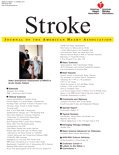Stroke:一种对颈动脉斑块进行量化分析的方法
预防脑栓塞是颈动脉支架(CAS)的一个重要问题。为此,日本Mie医学研究生院神经外科的HiroshiTanemura博士等人进行了一项研究,研究结果于2012年11月20日在线发表在Stroke杂志上。研究结果发现:3DT1加权梯度回波(3DT1GRE)序列有助CAS相关脑栓塞的预测。
研究人员使用3DT1GRE图像测量信号密度比值(SIR)和斑块容积,并对CAS前的47个颈动脉斑块特性进行量化分析。我们使用T1加权涡轮场回波序列获得3DT1GRE图像。研究人员也在CAS前后评估脑弥散加权图像(DWI)以检测脑血栓所致的缺血病灶(DWI病灶)。
研究结果发现:存在DWI病灶组(P组:n=26)相较没有DWI病灶组(N组:n=21):SIR(2.17[四分位1.50–3.07]对比1.35[四分位1.08–1.97];P=0.010)和斑块容积(456mm3[四分位256–696]对比301mm3[四分位:126–433];P=0.008)显著增高。根据多变量对数回归分析,SIR(P=0.007)和斑块容量(P=0.042)是CAS相关DWI病灶的独立预测因素。而且,SIR(rs=0.42,P=0.005)和斑块容量(rs=0.36,P=0.012)与DWI病灶数量正相关。根据受试者工作特性曲线分析发现:SIR和斑块容量预测CAS相关DWI病灶的最佳切线值分别为1.80和373mm3。
该研究发现:使用3DT1GRE图像对颈动脉斑块进行量化分析,有利于预测CAS相关的脑栓塞。

DOI:10.1161/STROKEAHA.112.663138
PMC:
PMID:
High-Risk Plaque for Carotid Artery Stenting Evaluated With 3-Dimensional T1-Weighted Gradient Echo Sequence
Hiroshi Tanemura, Masayuki Maeda, Naoki Ichikawa, Yoichi Miura, Yasuyuki Umeda, Seiji Hatazaki, Naoki Toma, Fumio Asakura, Hidenori Suzuki, Hiroshi Sakaida, Satoshi Matsushima, and Waro Taki
BACKGROUND AND PURPOSE: Preventing cerebral embolisms is a major concern with carotid artery stenting (CAS). This study evaluated 3-dimensional T1-weighted gradient echo (3D T1GRE) sequence to predict cerebral embolism related to CAS. METHODS: We performed quantitative analyses of the characteristics of 47 carotid plaques before CAS by measuring the signal intensity ratio (SIR) and plaque volume using 3D T1GRE images. We used T1-weighted turbo field echo sequence to obtain 3D T1GRE images. We also evaluated diffusion-weighted images (DWI) of the brain before and after CAS to detect ischemic lesions (DWI lesions) from cerebral emboli. RESULTS: SIR (2.17 [interquartile range 1.50-3.07] versus 1.35 [interquartile range 1.08-1.97]; P=0.010) and plaque volume (456 mm(3) [interquartile range 256-696] versus 301 mm(3) [interquartile range 126-433]; P=0.008) were significantly higher in the group of patients positive for DWI lesions (P-group: n=26) than DWI lesion-negative patients (N-group: n=21). In multivariate logistic regression analysis, SIR (P=0.007) and plaque volume (P=0.042) were independent predictors of DWI lesions with CAS. Furthermore, SIR (rs=0.42, P=0.005) and plaque volume (rs=0.36, P=0.012) were positively correlated with the number of DWI lesions. From analysis of a receiver-operating characteristic curve, the most reliable cutoff values of SIR and plaque volume to predict DWI lesions related to CAS were 1.80 and 373 mm(3), respectively. CONCLUSIONS: Quantitative evaluation of carotid plaques using 3D T1GRE images may be useful in predicting cerebral embolism related to CAS.
本站所注明来源为"爱爱医"的文章,版权归作者与本站共同所有,非经授权不得转载。
本站所有转载文章系出于传递更多信息之目的,且明确注明来源和作者,不希望被转载的媒体或个人可与我们
联系zlzs@120.net,我们将立即进行删除处理
热点图文
-
多参数MRI在前列腺癌精准诊断应用思考
随着前列腺癌发病率的逐年上升,精准诊断与分层治疗成为改善患者预后的关键。多...[详细]
-
带状疱疹神经疼痛的临床诊疗
综合治疗的必要性带状疱疹神经痛的治疗需要多模式、多学科的综合治疗策略。结合...[详细]

